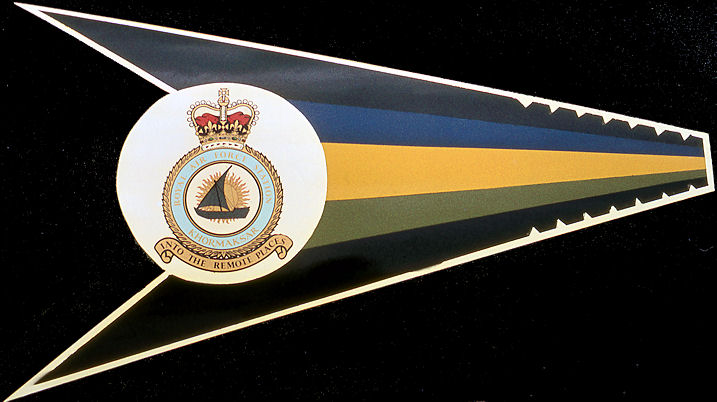|
|

|
|
The Hunter line at Khormaksar in 1963 with three 1417 Flt aircraft nearest the camera: FR.10s XE614-PL and XE599-JM plus T.7 XL613-Z ('Taff' John)
|
|

|
|
XE589-JM, Johnny Morris's aircraft, pictured on the Ksar pan in autumn 1963, has yet to received the 1417 Flight pennant on the its nose (Taff John)
|
|

|
|
OC 1417 Flight, Peter Lewis's FR.10, XE614-PL, stands ready for its next sortie on the Khormaksar line in late 1963 (Taff John)
|
|

|
|
Bearing Peter's initials on the fin, XE614-PL slides alongside the 'camera-ship' during a sortie from Khormaksar in 1964 (Peter Lewis)
|
|
.jpg)
|
|
XE599-JD flying low over Fort Ataq in 1963 (Roger Pyrah)
|
|

|
|
XF441-JD was the first Hunter to bear a full set of 1417 Flt markings, stands on the Khormaksar pan awaiting its next sortie. (author)
This aircraft is stored in a hangar in Australia awaiting a buyer. |
|
|
|

|
|
XE614-RJ after a period with 131 MU at Khormaksar in 1965 (Author's collection)
This aircraft is currently on static display at the Queensland Aviation Museum in Australia. |
|
.jpg)
|
|
Adorned with 1417 Flt markings, XE589-RC awaits post-refurb acceptence flight by Ralph Chambers, Khormaksar, 1964. (Ralph Chambers)
Ralph is hoping to locate this (his!) Hunter in Somalia and any assistance would be much appreciated. |
|
_1966_RC.jpg)
|
|
Birds eye view of XF436-RP over mountainous terrain in 1965. (Ralph Chambers)
|
|

|
|
Bearing the tailcode RJ, XE614 blends in well with the terrain below as it flies over the mountains in 1966 (Ken Simpson)
|
|

|
|
A year later and another view of XF436, re-coded PhN, flying low over an area of rolling bondu (Ken Simpson)
|
|
.jpg)
|
|
XF460-DB is seen parked on the Masirah apron while on detachment from Khormaksar in 1967. (Ray Deacon collection)
|
|
|
|

|
|
The cameras in the Mark 10 are exemplified in this view of XF460-DB at Masirah, 1967. Note the lens cover on the nose camera. (Ray Deacon collection)
|
|

|
|
Splendid overhead view of 1417 Flt FR.10, XF460-KS, somewhere over Aden (Ken Simpson) (were you at the controls Ken?)
|
|
_KS.jpg)
|
|
Taxiing in at Masirah in 1967 while looking through the offset gunsight, a unique feature of the FR.10 (Ken Simpson)
Having no radar ranging, the FR.10 gunsight was fixed and offset to the right to give the pilot better forward vision for map reading at very low levels, early target acquisitions and visual reconnaisance. |
|

|
|
One of several differences between the FGA.9 and FR.10, the G4F compass was positioned high up on the instrument panel (Ken Simpson)
This enabled the pilot to take his bearings without the distraction of having to look down into the cockpit, a particular benefit for low-level operations. |
|
|
|
|

|
|
Former 208 Squadron aircraft, XL597-W was transferred to 1417 Flight in March 1963 and was pictured on the Khormaksar pan in 1964. (author)
Although 'owned' by 1417 Flt, the four T.7s did not receive the pennant on the nose until some time later in 1964, although each received a tail code in the sequence W-Z in light blue. |
|

|
|
Pictured shortly after its arrival from then UK, XL612-X joined 1417 Flt in the summer of 1963. (author)
This aircraft was the last Hunter to serve with the RAF being withdrawn from service at Boscombe Down in August 2001. It is currently preserved in airworthy condition at Exeter. |
|

|
|
Initially used for manufacturers flight tests, XL565-Y arrived in Aden in 1960, a replacement for a lost aircraft. Posed at Khormaksar 1964. (author)
|
|

|
|
XL613-Z, one of T.7s sent out to Aden in 1959 to convert 8 Sqn pilots from the Venom. Here it heads the Khormaksar line up in 1964. (author)
The aircraft is currently airworthy with the Thunder City group based in Cape Town, South Africa. |
|

|
|
Bearing the markings of all three units, XL566-TW awaits the fitment of a nose cone at Khormaksar in 1965. (Mike Harris)
With the introduction of centralised pooling of all Khormaksar-based Hunters in the summer of 1964, each aircraft carried the markings of 8 and 208 Sqns and 1417 Flt, until the decision to de-centralise was taken twelve months or so later when they reverted to individual unit markings. |
|

|
|
Converted from a single-seat F.4 in 1959, XF321-TZ bore all three unit markings when seen on the Khormaksar pan in 1966 (Ivor Davies)
|
|
|

